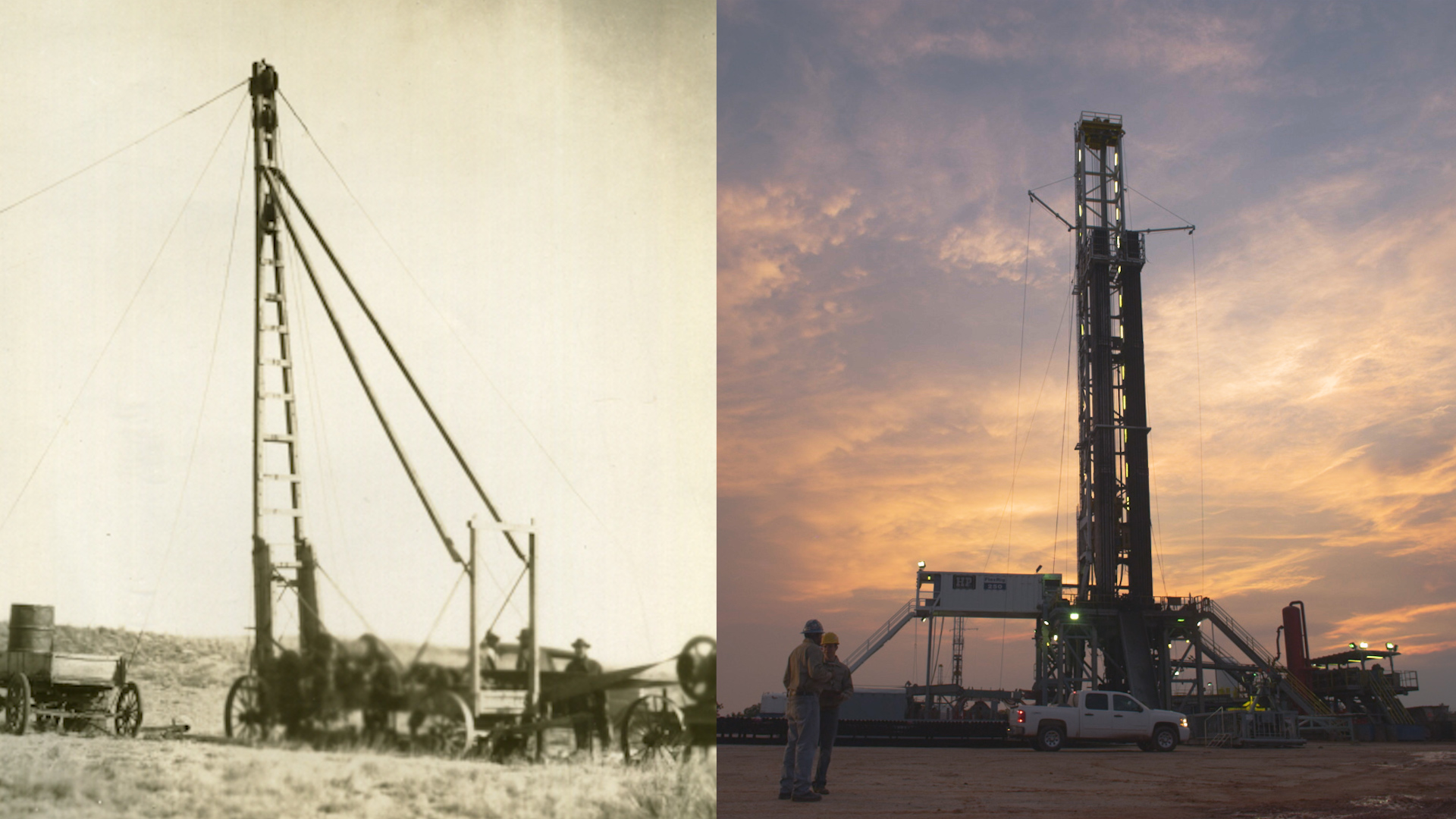A CENTURY OF DRILLING: HOW RIGS HAVE CHANGED TO BRING MORE EFFICIENCY, SAFETY AND ENVIRONMENTAL STEWARDSHIP TO THE OIL AND NATURAL GAS INDUSTRY.
Ever since discovering the benefits of oil and natural gas, we’ve been doing everything we can, including inventing new equipment and technology, to pull it out of the ground as safely and efficiently as possible. Many of these innovations have come in the way we use drilling rigs. Let’s take a look at how far we’ve come.
Many of these innovations have come in the way we use drilling rigs. Let’s take a look at how far we’ve come.
1850 – 1900
Oil had long been a by-product of salt drilling, but didn’t reach commercial production until 1859, when a drilling rig struck oil at 70 feet deep in Titusville, Pennsylvania.
These earliest rigs were made of wood, as they could be quickly built up. Back then, drilling was a gamble as rigs couldn’t be easily moved once they were built. These wooden rigs also proved dangerous during blowouts, or gushers, as they could catch fire if sparked.
Through this period, drilling rigs mostly used a percussive technique that worked by repeatedly slamming a cable tool into the ground. Rotary drill bits were quickly developed, as they drilled far deeper and faster than cable tools.
1900 – 1950
In 1901, The U.S. oil boom began in Beaumont, Texas, when a steam-powered rig that was using rotary drill bits and water-based drilling mud, caused a blowout that sent oil hundreds of feet into the air. This sent the U.S. into a frenzy.
Beaumont’s population of 10,000 tripled in three months. Within a year, more than 1,500 oil companies had been created as oil became the fuel of the modern era. As the need for oil products increased through World War I, production ramped up even more. With the increased production came innovation.
Many rigs traded in their wood frames for iron and steel. Blowouts, or gushers, mostly became a thing of the past in 1924 when the first blowout preventer (BOP) was invented. New drill bit designs and experiments in horizontal drilling improved efficiency entering into World War II. In 1947, the first offshore rig opened a vast new era in oil exploration.
1950 – 2000
The 1950s brought mechanical power to drilling rigs, foregoing steam for combustion engines. The 1970s advanced power once again by introducing on-site generators to power different components of the rig. The 70s also brought new technologies that allowed drill operators to accurately locate drill bits beneath the ground and measure while drilling.
This technology advancement eventually led to the steerable drilling systems developed in the 80s. In 1997, these advances were combined in a system that allowed drillers to precisely direct drilling while maintaining rotation.
2000 – Today
Advancements in both hardware and software contributed to a modern renaissance in drilling technology. Touch screens and joysticks turned the doghouse, or control booth, into a cockpit, as drill operators are able to precisely control drilling as if it were a video game.
In 2006, horizontal pad drilling led to greater efficiency while allowing one rig to do the job of many, lessening environmental impact. One rig is now able to drill multiple wellheads instead of having several rigs on a pad.
This technology improved even further when hydraulic “legs” were added allowing rigs to walk or “skid” across a pad. This led to even greater efficiencies as there was no longer a need for tear down and set up each time a rig had to be moved.
From wooden rigs using steam engines to our modern walking rigs – able to drill in multiple directions underneath the ground — we’ve come a long way in improving drilling efficiency and safety while decreasing impact on the environment.
TIMELINE
1859: Oil is first discovered in the U.S., when a rig near Titusville, Pennsylvania drilled 70 feet to strike oil.
1901: The U.S.’s first deep oil well gushes at Spindletop near Beaumont, Texas. The well used a combination of water-based drilling mud and a steam-driven rotary drill to reach the oil and natural gas deposits. The well’s success sparked an oil boom in the U.S.
1909: A patent is filed for the first steel roller-cone drill bit.
1924: The first blowout preventer (BOP) is brought to market preventing high-pressure blowouts, or gushers.
1933: Drill bits continue to advance with the tricone roller-cone drill bit.
1949: The Breton Rig 20 becomes the first offshore mobile drilling platform, able to perform in up to 20 feet of water.
1950: Drilling rigs begin operating with mechanical power, often powered through diesel engines instead of by steam.
1970: Drilling rigs move to electric power, using on-site generators to power rig components.
1972: Mud-pulse telemetry allows drilling rig operators to accurately determine bit location during drilling.
1978: Technology allows drilling rig operators to measure while drilling.
1984: The first steerable drilling system is introduced.
1997: The rotary closed-loop drilling system is introduced, allowing drillers to have precise directional control with continuous drilling rotation.
2001: Touch screens and joysticks are brought into the now climate-controlled doghouse.
2002: AC power is brought to commercial rigs, allowing for more safety and efficiency.
2006: Rigs are able to drill several wells on a pad, lessening the impact on the land while increasing efficiency.
2012: Rigs can walk or skid using hydraulic “legs” to move to the next drill site.

